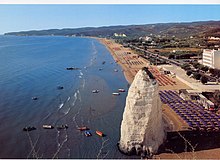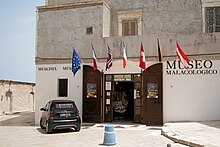 Vieste | ||
| Vieste | ||
| province | Foggia | |
|---|---|---|
| Residents | 13.943 (2018) | |
| height | 43 m | |
| no tourist info on Wikidata: | ||
| location | ||
| ||
Vieste is a city with 13,900 inhabitants. It is located on a rocky elevation on the eastern tip of the Gargano Peninsula and belongs to the province Foggia. The place is known for the extensive bathing beaches on both sides of the city, which make it the focus of bathing tourism on the Gargano Peninsula, and the port used for fishing, boat trips to the Tremiti Islands and for private yachts.
A landmark is the Pizzomunno, a 25 m high light limestone cliff that rises at the beginning of the beach of the same name in the south of the old town.
background

The coast around Vieste with the grottos and caves washed out of the karst rock and the sufficient amounts of precipitation thanks to the hilly hinterland with a simultaneously warm Mediterranean climate offered optimal conditions for settlement even in prehistoric times, including sites from the Stone Age and remains of an Iron Age burial site on the Point of headland of San Francesco testify.
The city on the rocky elevation above the harbor basin was ruled by the Byzantines, fell into the hands of the Lombards and later the Normans and Stauffer, who built the mighty Stauffer fort with the triangular floor plan above the old town. The city was badly hit by sieges by the Venetians and later the incursions of the Turkish Saracens under Dragut Reis, who in 1554 had practically the entire population of the town beheaded with 5,000 inhabitants. As in the rest of Apulia, the Angiovinians and the Aragonese followed, the city was integrated into the Kingdom of the Two Sicilies and ruled by the Burbons from Naples until the unification of Italy in 1861.
getting there


By plane
The closest airport is the 1 Aeroporto Internazionale di Bari "Karol Wojtyla" in the north of Bari, on the Gargano Peninsula, there are airfields only for private aviation and military use.
By train / bus
The best way to travel over is by train Foggia on, the railway line running along the Adriatic Sea Ferrovie dello Stato serves Foggia with express trains from Frecce, it continues with direct bus connections from Ferrovie del Gargano above Manfredonia to Vieste.
In the street
You can arrive by road via the motorway ![]() Bologna–Bari.
Bologna–Bari.
Coming from the north you can use the exit ![]() Poggio Imperiale-Gargano on the expressway
Poggio Imperiale-Gargano on the expressway ![]() direction Peschici drive, on the "Garganica" {{RSIGN | IT | SS | 89} you can reach Vieste from the north.
direction Peschici drive, on the "Garganica" {{RSIGN | IT | SS | 89} you can reach Vieste from the north.
You take them from the south ![]() Foggia and reaches the place on the winding coastal road "Garganica"
Foggia and reaches the place on the winding coastal road "Garganica" ![]() above Manfredonia (here expansion of the expressway).
above Manfredonia (here expansion of the expressway).
By boat
At the marina 1 Marina di Vieste There is enough space for private boats, but passenger ferry services are not offered here, but boat trips to the Isole Tremiti (Tremiti Islands) and those only accessible from the sea Sea grottoes on the Gargano cliffs.
mobility

One moves in the place on foot. Above all, the historic city center on the cliff with the Stauffer Fort and the Co-Cathedral with its narrow alleys and sometimes staircases must be visited on foot, access is only permitted to locals. From the north you can drive to the modern center on Corso Lorenzo Fazzini, there are a number of parking spaces here. Due to a one-way regulation, driving away is not permitted on the same route, but only via a small street along the harbor basin of the modern "Porto". Here, too, there are parking spaces again, but all of them are quickly allocated in high season.
Tourist Attractions





- the 2 Pizzomunno, a limestone rock on the beach in the south of the town, is the town's landmark.
The old town extends on a headland that drops steeply to the south, to the north the terrain to the historic harbor basin (the "Marina Piccola") slopes more gently, the alleys in the "Centro Storico" lead steeply to the cathedral and the Staufferkastell are partly designed as staircases.
In the northwest, the more modern Vieste joins the boulevard Corso Lorenzo Fazzini Baroque and classicist palazzi are lined up.
- the 3 Concattedrale di Santa Maria Assunta dates from the Romanesque period from the 11th century, between the twelfth and sixteenth centuries the cathedral experienced repeated damage and renovations during the time of the Saracen invasions and various earthquake disasters. The cathedral with the floor plan of a Latin cross was freed from changes from the Baroque period during the last restorations and now shows more of the original Romanesque building fabric. After its collapse, the church tower had to be rebuilt in 1772.
- Somewhat above is that which is still used by the military today and is therefore not accessible to visitors 4 Castello Svevo, the Stauffer Fortress. It is not accessible, from a small park in front you can catch a glimpse of the "Pizzomunno".
- on the Punta San Francesco stands the 5 Chiesa di San Francesco, the complex with an adjoining convent was built in 1438 and served after secularization in the 19th century. also as a military post and prison, from the Piazza di San Francesco there is a beautiful view of the old town, the old harbor basin and the island of Sant'Eufemia with the lighthouse. A trabucco, a wooden fishing rig with lifting nets ("fish gallows"), can be seen on the south coast.
- on the way to the old town you come to the little church 6 Chiesa di San Pietro past.
- near the Piazza della Libertà can the Shell Museum7 Museo Malacologico di Anna Ragno can be visited (free entry). From the promenade to the 1 Marina Piccola , the former port, you can enjoy a beautiful view of the 8 enjoy with the lighthouse.
- the 9 Museo Civico "M.Petrone" is on the way to the old town.
- at the Corso Lorenzo Fattini lies the 10 Palazzo Municipale, the Chiesa di San Giuseppe and of course a number of gelaterias, bars and boutiques.
Lying a little outside of town
- the simple lake chapel 11 Chiesa di San Lorenzo with origins in the 10th century.
- further north the Santuario 12 Santa Maria di Merino, also a chapel from 11/12. Century Its origins go back to the martyr and hermit San Marino who were murdered during the Saracen invasion in 988; Celestine V, who served briefly as Pope, was shipwrecked here in 1295 and was miraculously able to save himself on land.
- a natural spectacle worth seeing is the natural arc of the 13 Arco di San Felice in the bay a little to the south Baia di San Felice.
activities
- extensive Bathing beaches extend on both sides of the town, to the north, in the south at the beginning of the beach section is the limestone cone of the 25 m high Pizzomunno.
- The place is known for its good winds that allow it to be almost daily Windsurfing or to sail.
- in the nature reserve Parco Nazionale del Gargano with the Foresta Umbra in the hinterland can be extensive hikes between the coast and the original forest area, the foreland is largely covered with olive tree plantations.
- Boat trips and excursions with a rented boat to the numerous sea caves on the cliffs and the Tremiti Islands.
shop
Every 2nd Monday is market day. There is also a small fish market in the harbor.
kitchen
There are a number of bars, restaurants and gelateria in the vicinity of the city center.
nightlife
accommodation
In addition to hotels in the urban area, there are extensive beaches with campsites and holiday village complexes on both sides of the town.
- 1 Campeggio Apeneste Sosta Camper, Lungomare E. Mattei. Tel.: 39 884 706287.
- 2 Camping Adriatico Vieste, Lungomare E. Mattei. Tel.: 39 884 700954.
- 3 Villagio Turistico Euro 92, Lungomare E. Mattei. Tel.: 39 884 700968.
- 4 Camping Vieste - Villaggio San Michele, Litoranea Vieste Peschici. Tel.: 39 (0)884 705367.
security
health
Practical advice
On the Website the city you will find tourist information, under "Elenco completo strutture ricettive di Vieste" a comprehensive list of restaurants and accommodation.
trips
- in the fishing village Peschici further north
- Forays into the nature park Parco Nazionale del Gargano with the Foresta Umbra
- to the pilgrimage sites Monte Sant'Angelo and the place of activity of Padre Pio da Pitrelcina, San Giovanni Rotondo, mainly religiously motivated pilgrims set out.
literature
Web links
- http://egov.hseweb.it/vieste/ - Vieste official website



